
Broomcorn, or sorghum vulgare, is an annual that can grow to fifteen feet in a season. It is a crop grown primarily for the manufacture of brooms, and whisk brooms. It appears in the literature in the late 1500’s, in Italy; Benjamin Franklin is reputed to have introduced broomcorn to the US in 1700. Though I have been using broomcorn ornamentally in fall pots for years, the above mentioned facts I learned only yesterday. As I am focused on how plants look, I am impressed with that enterprising person that dried this plant, and made brooms. I will admit I did go and check out the broom in my office.
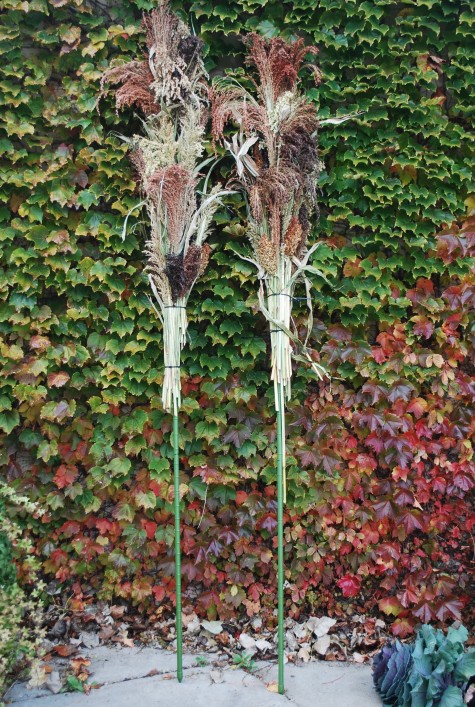
They make a swell centerpiece in a fall pot. For this six foot tall centerpiece, I loosely zip-tie two levels of material to a vinyl coated steel stake, and stuff my way down. The metal stake is a good idea-these stems are juicy, and very heavy. I like to use fresh cut sorghum and millet as they dry in whatever position you have them.
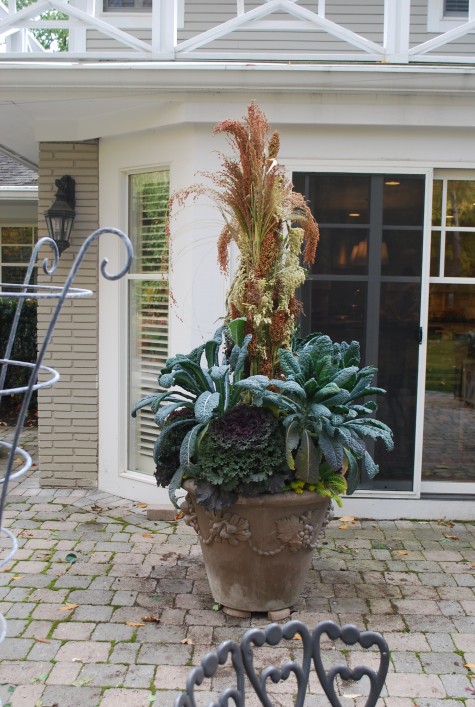 The metal stake is inserted as close to the bottom of the pot as possible. A listing, out of vertical centerpiece-on my top ten list of things I really dislike. The long fibrous panicle of the broomcorn plant arches over gracefully in a pot. I repeat that graceful arching with some leggy Tuscan blue kale; this combination is a good foil for those utterly organized cabbages.
The metal stake is inserted as close to the bottom of the pot as possible. A listing, out of vertical centerpiece-on my top ten list of things I really dislike. The long fibrous panicle of the broomcorn plant arches over gracefully in a pot. I repeat that graceful arching with some leggy Tuscan blue kale; this combination is a good foil for those utterly organized cabbages.
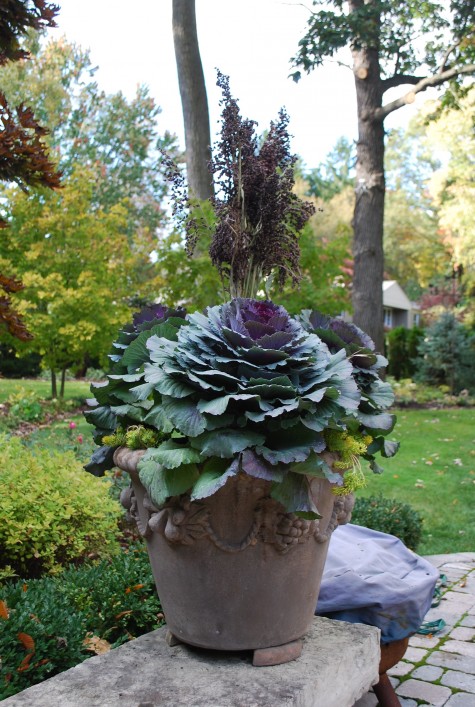 Sometimes I sort the broomcorn bunches for color. The dark stems are a beautiful compliment to this Francesco Del Re pot; plugs of angelina sedum infill the gaps. As I discussed yesterday, elevating the pots allows water to drain away freely. We will need this when dressing the pots for the winter.
Sometimes I sort the broomcorn bunches for color. The dark stems are a beautiful compliment to this Francesco Del Re pot; plugs of angelina sedum infill the gaps. As I discussed yesterday, elevating the pots allows water to drain away freely. We will need this when dressing the pots for the winter.
 The green-cream and peach sorghum contrasts well with its counterpart in a dark purple-brown. I do not know if any of these stems would pass muster for broom-making material, but they make for a great fall pot. That blue kale foliage is an unusual color in Michigan landscapes; it stands out.
The green-cream and peach sorghum contrasts well with its counterpart in a dark purple-brown. I do not know if any of these stems would pass muster for broom-making material, but they make for a great fall pot. That blue kale foliage is an unusual color in Michigan landscapes; it stands out.
 Ornamental cabbages only get better as the night temperatures drop; they color up. They are best planted as a tutu. Plants with a stiff aspect need some friendly and loose companionship. Thus this combination. The lime green angelina will take on an orange cast in cold weather, as in 37 degrees when I came to work this morning.
Ornamental cabbages only get better as the night temperatures drop; they color up. They are best planted as a tutu. Plants with a stiff aspect need some friendly and loose companionship. Thus this combination. The lime green angelina will take on an orange cast in cold weather, as in 37 degrees when I came to work this morning.
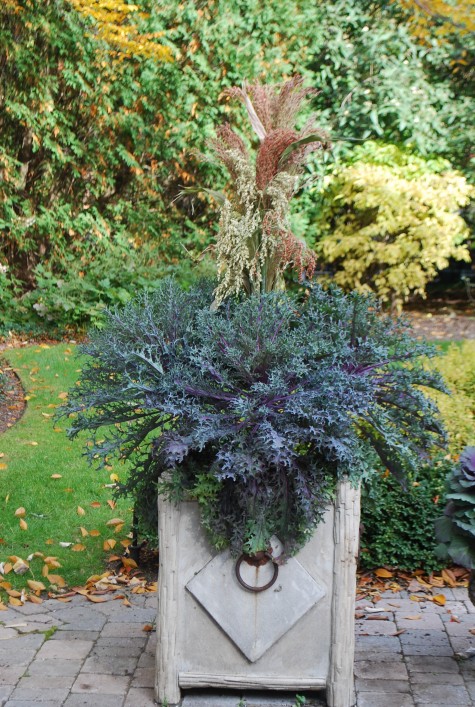 This lace leaf kale is all about air, at the same time that it defines an overall shape. What more could any gardener ask of a plant? As kales and cabbages shed their lower leaves, I may bury the trunk as needed in the soil, and pitch the head forward some. The entire arrangement-saucy enough to attract attention.
This lace leaf kale is all about air, at the same time that it defines an overall shape. What more could any gardener ask of a plant? As kales and cabbages shed their lower leaves, I may bury the trunk as needed in the soil, and pitch the head forward some. The entire arrangement-saucy enough to attract attention.
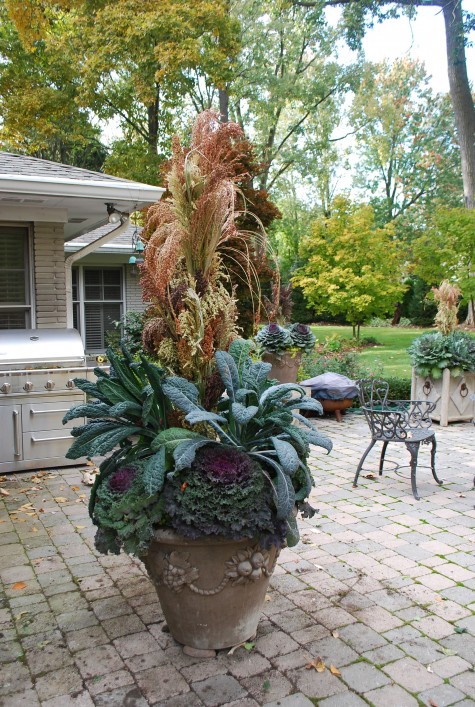
I plant my clients pots four times a year; her pair of concrete squares, and three Francesco Del Re pots get dressed up for each season. Every season she is looking out her kitchen window expecting to see something beautiful. I suppose if I made a big issue of the history and ornamental use of broomcorn, she would listen. But her attention to that horticulture would not be the point. As I try to provide her with a view to something, I am interested in any plant, including a big rangy annual usually grown as a crop, that delivers.

 Some forms are simply done, and reminiscent of the classic rolled rim terre cotta pot which has served gardeners well for centuries. Handmade terre cotta is fired for a long time-relative to the few hours allotted most machine made pots. This slow firing improves the strength and chip resistance remarkably. The flared shape makes potting and unpotting easy.
Some forms are simply done, and reminiscent of the classic rolled rim terre cotta pot which has served gardeners well for centuries. Handmade terre cotta is fired for a long time-relative to the few hours allotted most machine made pots. This slow firing improves the strength and chip resistance remarkably. The flared shape makes potting and unpotting easy.  Francesco Del Re fires their pots until they vitrify. Vitreous china and pottery refers to a clay which is subjected to sufficiently high heat for a time sufficient to turn the minerals in the clay glass-hard. I have left my handmade Italian pots out on occasion to weather the brutal Michigan winter-not a problem. But I am careful about certain things. I make sure there is a space, however small, between the pot, and the hard surface on which it sits. I might slide galvanized metal washers, or nickels under the pots. I want to insure that water drains away before it freezes and expands. Any water trapped under the pot will wreak havoc over a winter; thus I never recommend a winter outdoors for terre cotta to a client.
Francesco Del Re fires their pots until they vitrify. Vitreous china and pottery refers to a clay which is subjected to sufficiently high heat for a time sufficient to turn the minerals in the clay glass-hard. I have left my handmade Italian pots out on occasion to weather the brutal Michigan winter-not a problem. But I am careful about certain things. I make sure there is a space, however small, between the pot, and the hard surface on which it sits. I might slide galvanized metal washers, or nickels under the pots. I want to insure that water drains away before it freezes and expands. Any water trapped under the pot will wreak havoc over a winter; thus I never recommend a winter outdoors for terre cotta to a client.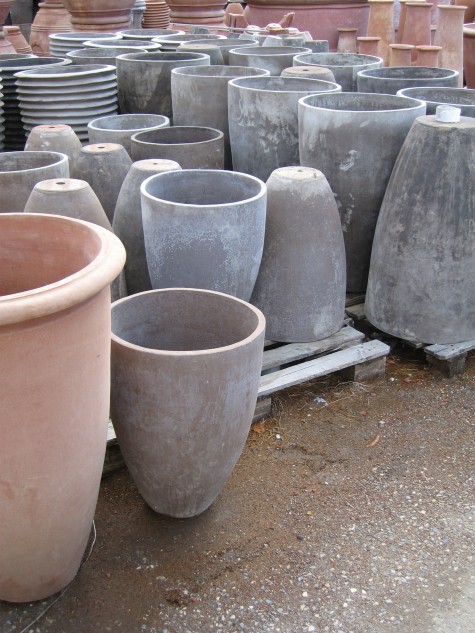
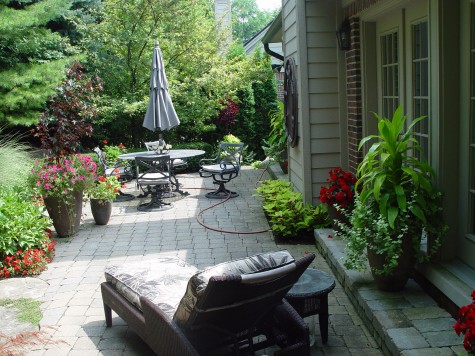 The pottery is guided by the design work of Elettra Brancolini; they refer to her as their artistic heart. Her distinctive design I would describe as softly modern, sometimes updated classical, and frequently very contemporary. I admire that the pottery has put their weight behind her hand. I am sure she gardens; the pots have a generous space at the top to plant. The proportions of this pot in all its sizes are perfection. They quietly and beautifully set off any planting. They are as beautiful indoors as out.
The pottery is guided by the design work of Elettra Brancolini; they refer to her as their artistic heart. Her distinctive design I would describe as softly modern, sometimes updated classical, and frequently very contemporary. I admire that the pottery has put their weight behind her hand. I am sure she gardens; the pots have a generous space at the top to plant. The proportions of this pot in all its sizes are perfection. They quietly and beautifully set off any planting. They are as beautiful indoors as out.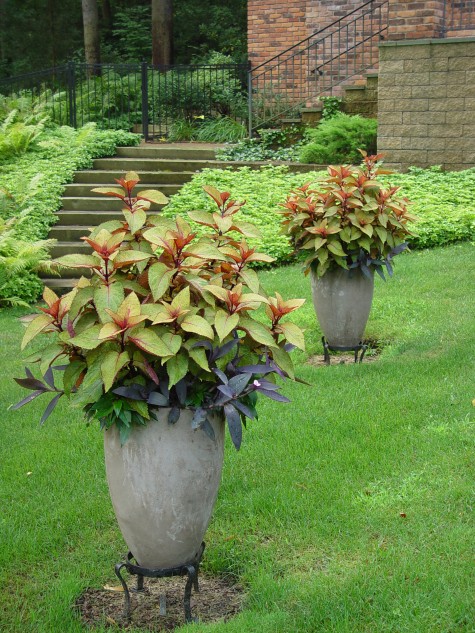
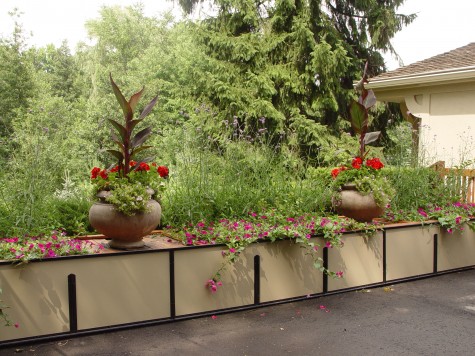 The color of the pots changes with the light, and appears different in different places. The creamy, barely yellow of this retaining wall has brought out the warm brown of the clay. Another cooler colored spot might make the pots read a warm grey.
The color of the pots changes with the light, and appears different in different places. The creamy, barely yellow of this retaining wall has brought out the warm brown of the clay. Another cooler colored spot might make the pots read a warm grey. 
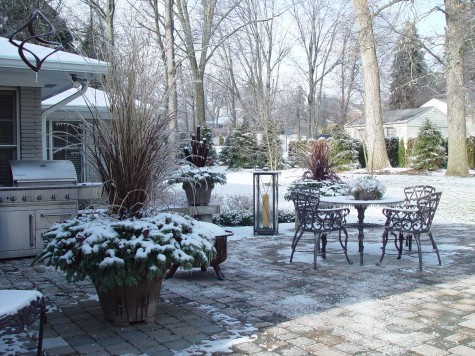
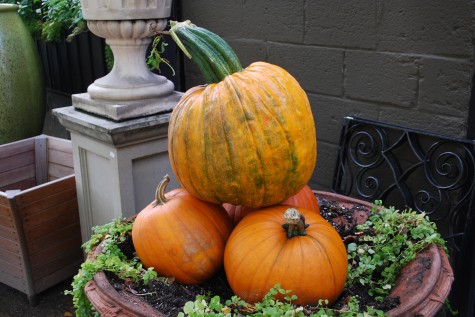 Whether I am drawing a plan, arranging some flowers, building a topiary sculpture, or staging a display, my first move is to determine the order of events. The big gesture comes first. In a landscape plan, I determine the center of interest, or organizing element, and place it. If it is a pool, that pool is assigned a size and a location; any other design is keyed to and in support of that initial decision. If the pool is centered in a space, I work from the middle to the edges of my paper. If that pool is located on a wall at the far end of my space, I would work from back to front, in tandem with establishing the views. As the topiaries that had spent the summer in these pots needed the shelter of a greenhouse, I had four empty pots in search of a reason to be. The idea of these pots overflowing with pumpkins squashes and gourds in some sculptural way had appeal. As these pots are large, a center of interest at a height pleasingly proportional to their width needed to be set first. I used a trio of medium sized pumpkins to get my big pumpkin with its giant stem at the right finished height.
Whether I am drawing a plan, arranging some flowers, building a topiary sculpture, or staging a display, my first move is to determine the order of events. The big gesture comes first. In a landscape plan, I determine the center of interest, or organizing element, and place it. If it is a pool, that pool is assigned a size and a location; any other design is keyed to and in support of that initial decision. If the pool is centered in a space, I work from the middle to the edges of my paper. If that pool is located on a wall at the far end of my space, I would work from back to front, in tandem with establishing the views. As the topiaries that had spent the summer in these pots needed the shelter of a greenhouse, I had four empty pots in search of a reason to be. The idea of these pots overflowing with pumpkins squashes and gourds in some sculptural way had appeal. As these pots are large, a center of interest at a height pleasingly proportional to their width needed to be set first. I used a trio of medium sized pumpkins to get my big pumpkin with its giant stem at the right finished height. 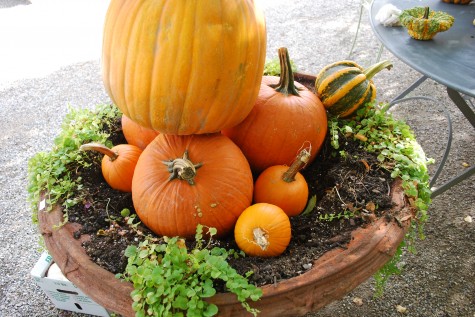 When working with rounded forms, it rarely works to use a filler material for height. Someplace your filler will show, and give the impression your slip is showing. Trying to cover up a not for viewing interior structure invariably looks like a cover up. Whatever portion of these support pumpkins might show in the finished piece, that portion will look like part of the arrangement. I would not have the faintest idea about how to turn pie pumpkins into pie, but I do know how to use them to provide crooks and crannies to set my prized specimen gourds. I set these beginning pumpkins at an angle which makes their swooping stems part of the action of the sculpture. This helps to make the sculpture look graceful. Every stem set straight up risks that soldierly, grocery store display look.
When working with rounded forms, it rarely works to use a filler material for height. Someplace your filler will show, and give the impression your slip is showing. Trying to cover up a not for viewing interior structure invariably looks like a cover up. Whatever portion of these support pumpkins might show in the finished piece, that portion will look like part of the arrangement. I would not have the faintest idea about how to turn pie pumpkins into pie, but I do know how to use them to provide crooks and crannies to set my prized specimen gourds. I set these beginning pumpkins at an angle which makes their swooping stems part of the action of the sculpture. This helps to make the sculpture look graceful. Every stem set straight up risks that soldierly, grocery store display look.  As I am interested in placing the largest gourds next, and then, arranging with color in mind, I need to look at averything I have available all at once. This can be quite a nuisance when building a stone wall, but I would not know how to construct it otherwise. In designing a landscape, a lot of shapes, textures and volumes need to be available to your mind’s eye, all at once. I am only good for a random thought that might be pertinent when I am tired; it takes energy to concentrate enough to turn off the daily noise and design. This is easy-get the gourds out, and spread them around.
As I am interested in placing the largest gourds next, and then, arranging with color in mind, I need to look at averything I have available all at once. This can be quite a nuisance when building a stone wall, but I would not know how to construct it otherwise. In designing a landscape, a lot of shapes, textures and volumes need to be available to your mind’s eye, all at once. I am only good for a random thought that might be pertinent when I am tired; it takes energy to concentrate enough to turn off the daily noise and design. This is easy-get the gourds out, and spread them around.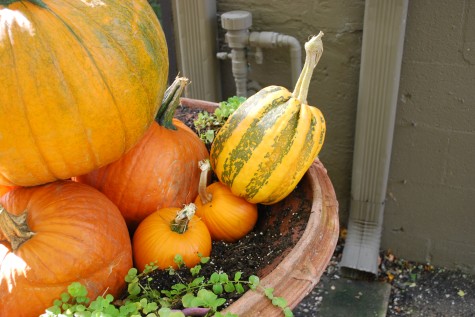 My big beautiful squashes get placed next. When I look at the four pots from the drive, I see that the pots furthest from my eye will need more emphasis than the pots close to my eye; bigger material is a good way to get what is far away to read better. A small pie pumpkin enables me to tilt the squash out over the edge of the pot, and feature the stem.
My big beautiful squashes get placed next. When I look at the four pots from the drive, I see that the pots furthest from my eye will need more emphasis than the pots close to my eye; bigger material is a good way to get what is far away to read better. A small pie pumpkin enables me to tilt the squash out over the edge of the pot, and feature the stem. 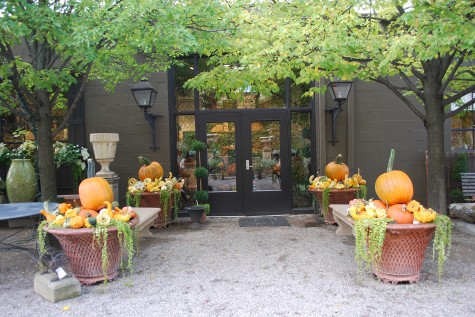 I finish placing all the large gourds, and stand back for a look. Though not so readily apparent in this picture, I have placed more of the pale or light colored gourds in the rear pots, and the darker colored gourds in the front pots. Dark colors do not read well at a distance, so placing them up front makes the detail of their shape and color read better. Pale colors read fine at a distance, and highlight dark colors placed in front of them. The pots are ready for the little bits-the smallest gourds finish and refine the shape of the overall arrangement. In a landscape, I might be planting roses at this stage, or groundcover as part of the finishing touches.
I finish placing all the large gourds, and stand back for a look. Though not so readily apparent in this picture, I have placed more of the pale or light colored gourds in the rear pots, and the darker colored gourds in the front pots. Dark colors do not read well at a distance, so placing them up front makes the detail of their shape and color read better. Pale colors read fine at a distance, and highlight dark colors placed in front of them. The pots are ready for the little bits-the smallest gourds finish and refine the shape of the overall arrangement. In a landscape, I might be planting roses at this stage, or groundcover as part of the finishing touches.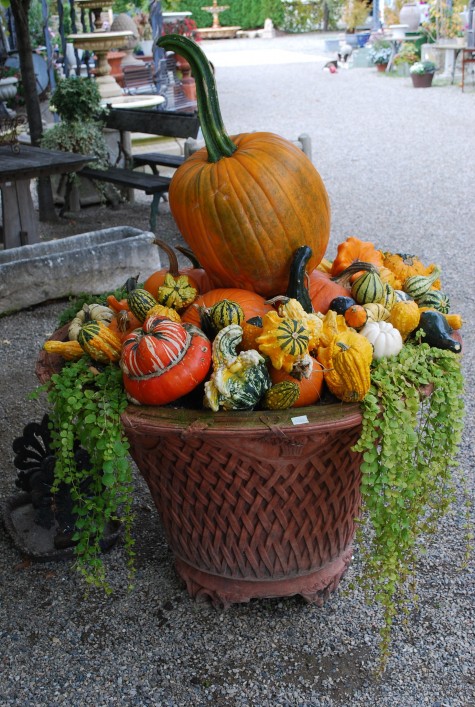 The idea is suggest a casual and not too fussy an arrangement. In fact, ordering the placement of sizes permits an arrangement where all the pieces are built sensibly from a large base supporting the fine detail-both visually, and physically. In a large flower arrangement, the interlocking big stems under water provide a framework that will hold the smaller stems where you want them. In a landscape, a long walk indicates how a garden is meant to be experienced-but it also provides weight and organization to the smaller elements you otherwise might not notice. All the elements of any composition need to interlock for a strong presentation of the whole. This front pot features dark and intense colors, with dashes of pale colors here and there.
The idea is suggest a casual and not too fussy an arrangement. In fact, ordering the placement of sizes permits an arrangement where all the pieces are built sensibly from a large base supporting the fine detail-both visually, and physically. In a large flower arrangement, the interlocking big stems under water provide a framework that will hold the smaller stems where you want them. In a landscape, a long walk indicates how a garden is meant to be experienced-but it also provides weight and organization to the smaller elements you otherwise might not notice. All the elements of any composition need to interlock for a strong presentation of the whole. This front pot features dark and intense colors, with dashes of pale colors here and there.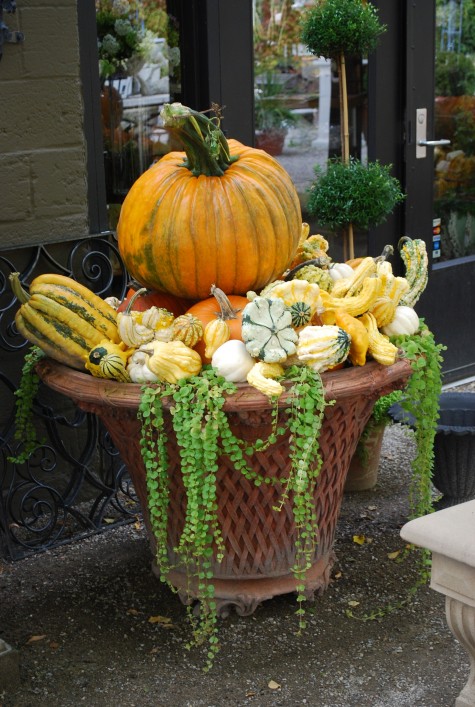 This rear pot set in a much darker environment relies on the interaction of pale colored shapes for good visibility. The varying shapes and colors of all the little noisy gourds emphasize the mass and grace of the shape of my starring pumpkin.
This rear pot set in a much darker environment relies on the interaction of pale colored shapes for good visibility. The varying shapes and colors of all the little noisy gourds emphasize the mass and grace of the shape of my starring pumpkin.